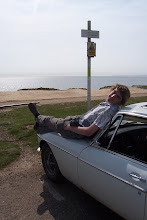The bulkhead was in a state. To make sense of what I have done, I will refer to the bulkhead in three parts. The central chunk, and the outer third at each side. The centre of the bulkhead was in good order, but the outer third on both sides had rotted to not very much at all. Of course, I am only dealing with the nearside at the moment, so I had to do something about the nearside outer third. Does that make sense?
 The outer Third of the bulkhead, looking rather sorry for itself. This had a plate fixed underneath, with gave it some strength, but it still wasn't really up to standard.....!
The outer Third of the bulkhead, looking rather sorry for itself. This had a plate fixed underneath, with gave it some strength, but it still wasn't really up to standard.....!I’d bought a bulkhead section from a scrap car, this was the only saveable bit from the whole car. I contemplated replacing the entire bulkhead, but due to its sheer size, weight and complexity, this was decided against to avoid distortion. So I used parts of my spare bulkhead, mainly the complicated curves and intricate parts, to replace the worst areas. In the end, I cut out most of the outer third, and fabricated a repair chunk using some parts of the spare bulkhead. This was then welded in, and with the utmost of groovyness, it fitted perfectly and seamlessly due to some careful welding and grinding. It was a huge amount of work, but very worthwhile, as I will have a sound and solid bulkhead, and with adequate protection it should last a good long while.
 This is just how much I fabricated. That's a lot of new metal, the curvy bits and holes were grafted in from my spare bulkhead.
This is just how much I fabricated. That's a lot of new metal, the curvy bits and holes were grafted in from my spare bulkhead.
......Giving this. Hello Vicar! Delicious shiny metal at last, and solid as a very solid rock which has just been hardness tested to 8.9 on Mohs' scale of hardness. You can see the joins.. .You can't feel them! Just wait until there's some primer on there. That's without any lead loading, too!
With the bulkhead done, I could turn my attention to the new dash side. This forms the left hand side of the footwell on the nearside. The problem here was the fact I couldn’t remove all of the original panel, as the two strengthening bars I had welded in were attached to the dash side. This did not cause a big problem, I just had to leave two small areas of the old panel in place, and cut corresponding pieces out of the new panel. I stripped the paint of it (Why do people buy Heritage panels, fit them and leave the inadequate Heritage paint on them? It’s only to protect the panels in storage and transit, and has the anti-rust capabilities of a small Norwegian hatstand. Trial-fitting it in place, it went straight in and was a perfect fit. Good, I hadn’t distorted anything!
Before welding it in place, I treated the inside of the A-post, as this was about to become a box section again. And we don’t like untreated box sections here! I used some Jenolite and some Bilt Hamber Deox gel to remove the surface rust, two products I have been recommended by various people, and was keen to try out. Both worked very well.
The areas I couldn’t reach were a problem. There will always be somewhere you can’t get a wire brush into, and that’s just the place that worries me. Those little somewheres that you can’t get to, which won’t be treated as well as everywhere else. That’s just the sort of thing I hate, and need to eliminate. The answer seems to be Rustbuster rust converter. This is not acidic, so you don’t have to remove it after use, perfect for the places you can’t properly get to. It does not remove the rust as such, but it encapsulates it and stops further damage. So it seems perfect for those hidden places which you can’t properly get to. All accessible places inside the A post got a decent coat of zinc primer.

The A-Post. Plenty of rust converter, and weld-through etch primer on the flanges.
So, happy that the A-post was not going to cause me trouble for a while, I prepared the new dash side for welding in. The areas where it would be welded to the A-post, bulkhead and footwell end were given a coat of weld through primer. So were the areas of the A-post, bulkhead and footwell end, where they would meet the dash side. It was then plug welded in place, using the holes created by drilling out the spot welds holding the old panel in place.

Welding in the new dash side. She's taking shape alright! And a perfect fit, to boot.
At this point, I decided I would seam weld everything as well. Well, not quite everything, discussions with people who utterly rag their BGTs on racetracks and such have been helping me in planning to create a stronger body shell without compromising flexibility. So many panel joins will be seam welded as well as plug welded in the original places, which should help to keep the water out.

No comments:
Post a Comment